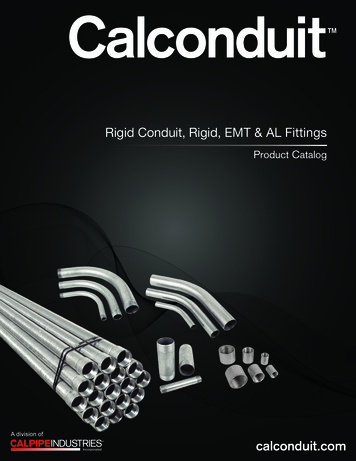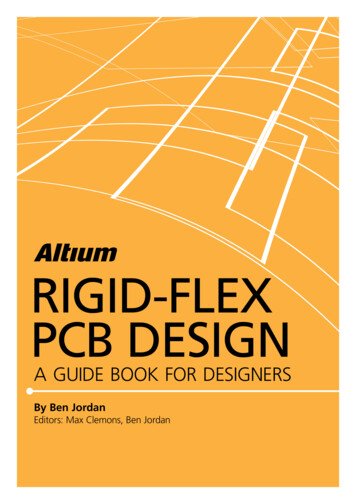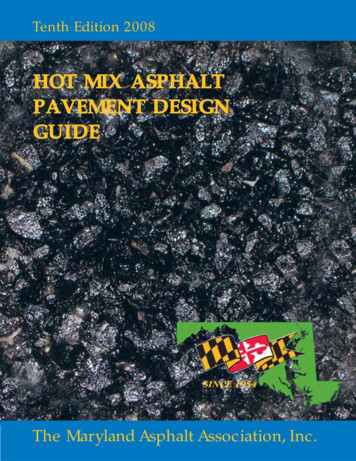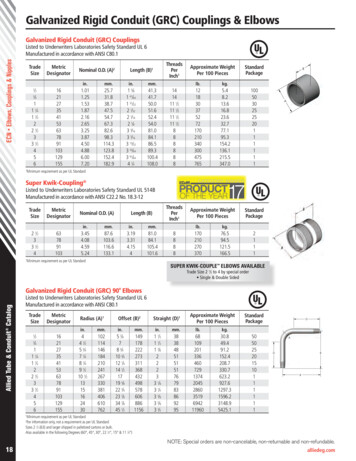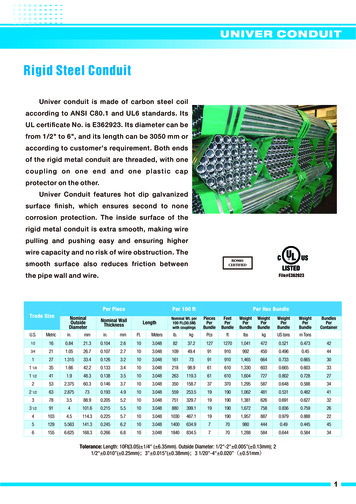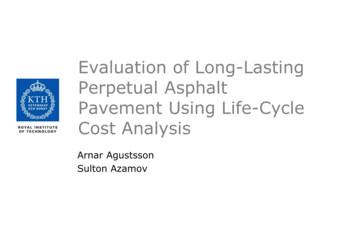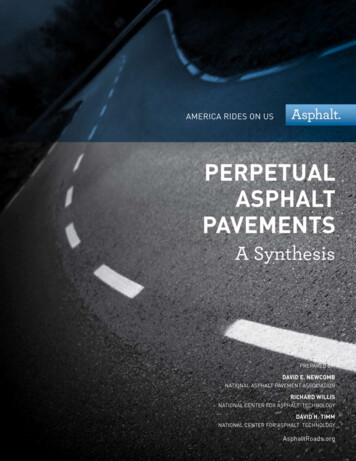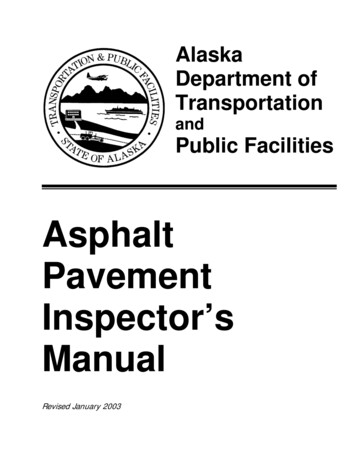
Transcription
Introduction to Rigid PavementDesignCourse No: C02-020Credit: 2 PDHJ. Paul Guyer, P.E., R.A., Fellow ASCE, Fellow AEIContinuing Education and Development, Inc.9 Greyridge Farm CourtStony Point, NY 10980P: (877) 322-5800F: (877) 322-4774info@cedengineering.com
An IntroductiontoRigid PavementDesignGuyer Partners44240 Clubhouse DriveEl Macero, CA 95618(530)758-6637jpguyer@pacbell.net J. Paul Guyer 2009J. Paul Guyer, P.E., R.A.Paul Guyer is a registered civil engineer,mechanical engineer, fire protection engineer,and architect with over 35 years experience inthe design of buildings and relatedinfrastructure. For an additional 9 years hewas a senior-level advisor to the CaliforniaLegislature. He is a graduate of StanfordUniversity and has held numerous national,state and local positions with the AmericanSociety of Civil Engineers and National Societyof Professional Engineers.1
This course is adapted from the Unified Facilities Criteria of the United States government,which is in the public domain, has unlimited distribution and is not copyrighted. J. Paul Guyer 20092
CONTENTS1. INTRODUCTION2. RIGID PAVEMENT DESIGN2.1 Soil Classification and Tests2.2 Compaction2.2.1 General2.2.2 Requirements2.2.3 Special Soils2.3 Treatment of Unsuitable Soils2.4 Determination of Modulus of Subgrade Reaction3. RIGID PAVEMENT BASE COURSE3.1 General Requirements3.2 Materials3.3 Compaction3.4 Frost Requirements4. CONCRETE PAVEMENT4.1 Mix Proportioning and Control4.2 Testing4.3 Special Conditions5. PLAIN CONCRETE PAVEMENT DESIGN5.1 Roller-Compacted Concrete Pavements5.2 Design Procedure6. REINFORCED CONCRETE PAVEMENT DESIGN6.1 Application J. Paul Guyer 20093
6.1.1 Subgrade conditions6.1.2 Economic considerations6.2 Design Procedure6.2.1 Thickness design on unbound base or subbase6.2.2 Thickness design on stabilized base or subgrade6.3 Limitations6.4 Reinforcing Steel6.4.1 Type of reinforcing steel6.4.2 Placement of reinforcing steel6.5 Design Example6.6 Typical Details J. Paul Guyer 20094
1. INTRODUCTIONThis is an introduction to rigid pavement design for engineers. It is not intended asdefinitive treatise, and it does not encompass the design of flexible pavements.Engineers are cautioned that much of pavement design is governed by codes,specifications and practices of public agencies. Engineers must always determine therequirements of the regulatory authority within whose jurisdiction specific projects fall. J. Paul Guyer 20095
2. RIGID PAVEMENT DESIGN2.1 Soil Classification and TestsAll soils should be classified according to the Unified Soil Classification System (USGS)as given in ASTM D 2487. There have been instances in construction specificationswhere the use of such terms as "loam," “gumbo,” "mud," and "muck" have resulted inmisunderstandings. These terms are not specific and are subject to differentinterpretations throughout the United States. Such terms should not be used. Sufficientinvestigations should be performed at the proposed site to facilitate the description of allsoils that will be used or removed during construction in accordance with ASTM D 2487;any additional descriptive information considered pertinent should also be included. IfAtterberg limits are a required part of the description, as indicated by the classificationtests, the test procedures and limits should be referenced in the constructionspecifications.2.2 Compaction2.2.1 General. Compaction improves the stability of the subgrade soils and provides amore uniform foundation for the pavement. ASTM D 1557 soil compaction testconducted at several moisture contents is used to determine the compactioncharacteristics of the subgrade soils. This test method should not be used if the soilcontains particles that are easily broken under the blow of the tamper unless the fieldmethod of compaction will produce a similar degradation. Certain types of soil mayrequire the use of a laboratory compaction control test other than the above-mentionedcompaction test. The unit weight of some types of sands and gravels obtained using thecompaction method above may be lower than the unit weight that can be obtained byfield compaction; hence, the method may not be applicable. In those cases where ahigher laboratory density is desired, compaction tests are usually made under somevariation of the ASTM D 1557 method, such as vibration or tamping (alone or in J. Paul Guyer 20096
combination) with a type hammer or compaction effort different from that used in thetest.2.2.2 Requirements. For all subgrade soil types, the subgrade under the pavementslab or base course must be compacted to a minimum depth of 6 inches. If thedensities of the natural subgrade materials are equal to or greater than 90 percent ofthe maximum density from ASTM D 1557, no rolling is necessary other than thatrequired to provide a smooth surface. Compaction requirements for cohesive soils (LL 25; PI 5) will be 90 percent of maximum density for the top 6 inches of cuts and thefull depth of fills. Compaction requirements for cohesionless soils (LL 25: PI 5) willbe 95 percent for the top 6 inches of cuts and the full depth of fills. Compaction of thetop 6 inches of cuts may require the subgrade to be scarified and dried or moistened asnecessary and recompacted to the desired density.2.2.3 Special Soils. Although compaction increases the stability and strength of mostsoils, some soil types show a marked decrease in stability when scarified, worked, androlled. Also, expansive soils shrink excessively during dry periods and expandexcessively when allowed to absorb moisture. When any of these types areencountered, special treatment will be required. For nominally expansive soils, watercontent, compaction effort, and overburden should be determined to control swell. Forhighly expansive soils, replacement to depth of moisture equilibrium, raising grade, limestabilization, prewetting, or other acceptable means of controlling swell should beconsidered.2.3 Treatment of Unsuitable Soils. Soils not suitable for subgrade use should beremoved and replaced or covered with soils which are suitable. The depth to which suchadverse soils should be removed or covered depends on the soil type, drainageconditions, and depth of freezing temperature penetration and should be determined bythe engineer on the basis of judgment and previous experience, with due considerationof the traffic to be served and the costs involved. Where freezing temperaturespenetrate a frost-susceptible subgrade, special design procedures should be followed. J. Paul Guyer 20097
In some instances, unsuitable or adverse soils may be improved economically bystabilization with such materials as cement, flyash, lime, or certain chemical additives,whereby the characteristics of the composite material become suitable for subgradepurposes. However, subgrade stabilization should not be attempted unless the costsreflect corresponding savings in base-course, pavement, or drainage facilitiesconstruction.2.4 Determination of Modulus of Subgrade Reaction. For the design of rigidpavements in those areas where no previous experience regarding pavementperformance is available, the modulus of subgrade reaction k to be used for designpurposes is determined by the field plate-bearing test. This test procedure and themethod for evaluating its results are not part of this discussion. Where performancedata from existing rigid pavements are available, adequate values for k can usually bedetermined on the basis of consideration of soil type, drainage conditions, and frostconditions that prevail at the proposed site. Table 2-1 presents typical values of k forvarious soil types and moisture conditions. These values should be considered as aguide only, and their use in lieu of the field plate-bearing test, although notrecommended, is left to the discretion of the engineer. Where a base course is usedunder the pavement, the k value on top of the base is used to determine the modulus ofsoil reaction on top of the base. The plate-bearing test may be run on top of the base,or figure 2-1 may be used to determine the modulus of soil reaction on top of the base.It is good practice to confirm adequacy of the k on top of the base from figure 2-1 byrunning a field plate-load test. J. Paul Guyer 20098
Table 2-1Modulus of Soil ReactionFigure 2-1Effect of Base-Course Thickness on Modulus of Soil Reaction J. Paul Guyer 20099
3. RIGID PAVEMENT BASE COURSES3.1 General Requirements. Base courses may be required under rigid pavementsfor replacing soft, highly compressible or expansive soils and for providing the following: Additional structural strength. More uniform bearing surface for the pavement. Protection for the subgrade against detrimental frost action. Drainage. Suitable surface for the operation of construction equipment, especiallyslipform pavers.Use of base courses under a rigid pavement to provide structural benefit should bebased on economy of construction. The first cost is usually less for an increase inthickness than for providing a thick base course. However, thick base courses haveoften resulted in lower maintenance costs since the thick base course provides strongerfoundation and therefore less slab movement. A minimum basecourse thickness of 4inches is required over subgrades that are classified as OH, CH, CL, MH, ML, and OLto provide protection against pumping. In certain cases of adverse moisture conditions(high water table or poor drainage), SM and SC soils also may require base courses toprevent pumping. The designer is cautioned against the use of fine-grained material forleveling courses or choking open-graded base courses since this may create a pumpingcondition. Positive drainage should be provided for all base courses to ensure water isnot trapped directly beneath the pavement since saturation of these layers will causethe pumping condition that the base course is intended to prevent.3.2 Materials. If conditions indicate that a base course is desirable under a rigidpavement, a thorough investigation should be made to determine the source, quantity,and characteristics of the available materials. A study should also be made to determinethe most economical thickness of material for a base course that will meet therequirements. The base course may consist of natural, processed, or stabilizedmaterials. The material selected should be the one that best accomplishes the intendedpurpose of the base course. In general, the base- course material should be a well J. Paul Guyer 200910
graded, high-stability material. In this connection all base courses to be placed beneathconcrete pavements for military roads and streets should conform to the followingrequirements: Percent passing No.10 sieve; Not more than 85. Percent passing No.200 sieve: Not more than 15. Plasticity index: Not higher than 6.Where local experience indicates their desirability, other control limitations such aslimited abrasion loss may be imposed to ensure a uniform high quality base course.3.3 Compaction. Where base courses are used under rigid pavements, the basecourse material should be compacted to a minimum of 95 percent of the maximumdensity. The engineer is cautioned that it is difficult to compact thin base courses tohigh densities when they are placed on yielding subgrades.3.4 Frost Requirements. In areas where subgrade soils are subjected to seasonalfrost action detrimental to the performance of pavements, the requirements for basecourse thickness and gradation will follow the criteria in this discussion. J. Paul Guyer 200911
4. CONCRETE PAVEMENT4.1 Mix Proportioning and Control. Normally, a design flexural strength at 28-dayage will be used for the pavement thickness determination. Should it be necessary touse the pavements at an earlier age, consideration should be given to the use of adesign flexural strength at the earlier age or to the use of high early strength cement,whichever is more Mix proportion or pavement thickness may have to economical.Flyash gains strength more slowly than cement, so that if used it may be desirable toselect a strength value at a period other than 28 days if time permits.4.2 Testing. The flexural strength of the concrete and lean concrete base will bedetermined in accordance with ASTM C 78. The standard test specimen will be a 6- by6-inch section long enough to permit testing over a span of 18 inches. The standardbeam will be used for concrete with the maximum size aggregate up to 2 inches. Whenaggregate larger than the 2-inch nominal size is used in the concrete, the crosssectional dimensions of the beam will be at least three times the nominal maximum sizeof the aggregate, and the length will be increased to at least 2 inches more than threetimes the depth.4.3 Special Conditions. Mix proportion or pavement thickness may have to beadjusted due to results of concrete tests. If the tests show a strength gain less thanpredicted or retrogression in strength, then the pavement would have to be thicker. Ifthe concrete strength was higher than predicted, then the thickness may be reduced.Rather than modifying the thickness required as a result of tests on the concrete, themix proportioning could be changed to increase or decrease the concrete strength,thereby not changing the thickness. J. Paul Guyer 200912
5. PLAIN CONCRETE PAVEMENT DESIGN5.1 Roller-Compacted Concrete Pavements. Roller-compacted concrete pavements(RCCP) are plain concrete pavements constructed using a zero-slump portland cementconcrete mixture that is placed with an AC paving machine and compacted withvibratory and rubber-tired rollers.5.2 Design Procedure. For convenience in determining design requirements, theentire range of vehicle loadings and traffic intensities anticipated during the design lifeof pavements for the various classifications of roads and streets has been expressed asan equivalent number of repetitions of an 18,000- pound single-axle loading. To
ASTM D 1557 soil compaction test conducted at several moisture contents is used to determine the compaction characteristics of the subgrade soils. This test method should not be used if the soil contains particles that are easily broken under the blow of the tamper unless the field method of compaction will produce a similar degradation. Certain types of soil may require the use of a .
